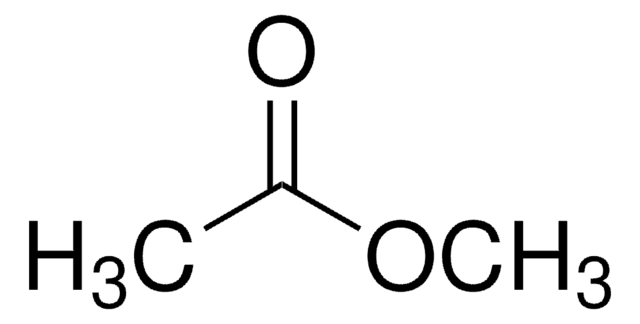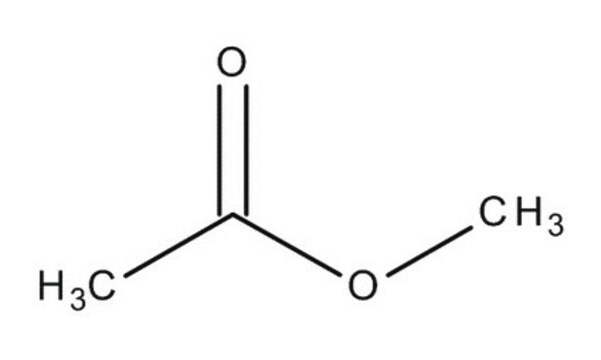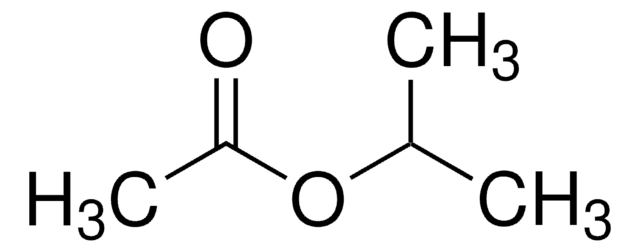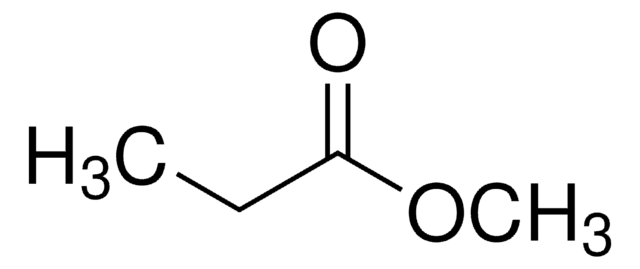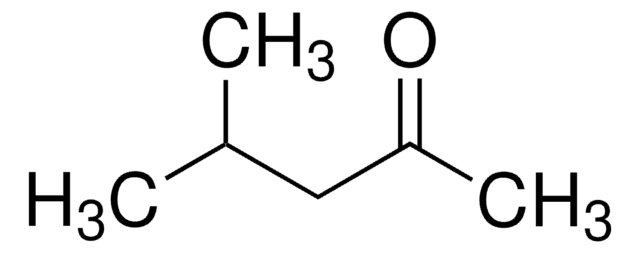About This Item
Recommended Products
vapor density
2.55 (vs air)
vapor pressure
165 mmHg ( 20 °C)
Assay
≥99.8% (GC)
≥99.8%
form
liquid
autoignition temp.
936 °F
shelf life
limited shelf life, expiry date on the label
expl. lim.
16 %
technique(s)
HPLC: suitable
impurities
≤0.05% water
evapn. residue
≤0.001%
refractive index
n20/D 1.361 (lit.)
n20/D 1.362
bp
57-58 °C (lit.)
mp
−98 °C (lit.)
density
0.934 g/mL at 25 °C
solvent strength ε (Al2O3)
0.60
λ
1 cm path, H2O reference
UV absorption
λ: 255 nm Amax: 1.0
λ: 275 nm Amax: 0.1
λ: 300 nm Amax: 0.01
SMILES string
COC(C)=O
InChI
1S/C3H6O2/c1-3(4)5-2/h1-2H3
InChI key
KXKVLQRXCPHEJC-UHFFFAOYSA-N
Looking for similar products? Visit Product Comparison Guide
Application
- Agglomeration of celecoxib by quasi-emulsion solvent diffusion method without stabilizer: effect of good solvent.: This research explored the agglomeration of celecoxib using the quasi-emulsion solvent diffusion method, highlighting the role of methyl acetate as a good solvent to improve particle size and distribution without the need for stabilizers (Maghsoodi & Nokhodchi, 2018).
- Formulation and in vitro evaluation of ketoprofen in palm oil esters nanoemulsion for topical delivery.: The formulation and evaluation of ketoprofen in a nanoemulsion system for topical delivery were examined, with methyl acetate used as a solvent to enhance solubility and stability of the active ingredient (Sakeena et al., 2010).
- Preparation of surfactant-free nanoparticles of methacrylic acid copolymers used for film coating.: This paper presented a method for preparing surfactant-free nanoparticles using methyl acetate as a solvent, emphasizing its role in the formation of uniform nanoparticle dispersions for coating applications (Nguyen et al., 2006).
Signal Word
Danger
Hazard Statements
Precautionary Statements
Hazard Classifications
Eye Irrit. 2 - Flam. Liq. 2 - STOT SE 3
Target Organs
Central nervous system
Supplementary Hazards
Storage Class Code
3 - Flammable liquids
WGK
WGK 1
Flash Point(F)
8.6 °F - closed cup
Flash Point(C)
-13 °C - closed cup
Choose from one of the most recent versions:
Already Own This Product?
Find documentation for the products that you have recently purchased in the Document Library.
Customers Also Viewed
Articles
Butyl methyl ether; Acetic acid; 2-Butanone; Ethyl acetate; Tetrahydrofuran; 1-Butanol; Isopropyl acetate; Heptane; Propyl acetate; 3-Methylbutanol; 4-Methyl-2-pentanone; Isobutyl acetate; Butyl acetate; Dimethyl sulfoxide; Anisole; Cumene
Protocols
-Cymene; (−)-Menthone; α-Terpineol, natural, ≥96%, FCC, FG; Terpinolene; β-Bourbonene; 1-Octen-3-ol; β-Caryophyllene; Linalool; α-Terpinene; (−)-Menthol
Separation of Acetone; Acetic acid; Propionic acid; Ethyl butyrate; Ethanol; Isoamyl acetate; Isobutyric acid; 3-Methyl-2-butanol; Methyl acetate; 1-Propanol; Acetal, ≥98%, FG; 2-Methyl-1-pentanol; Butyl acetate; Ethyl propionate; 3-Pentanol; 2-Pentanol, 98%; Ethyl isobutyrate; Isobutyl acetate; Acetaldehyde; Furfural; Butyric acid; Methanol; Ethyl acetate
Protocol for GC Analysis of Class 3 Residual Solvents on SUPELCOWAX® 10
-Cymene; 2,5-Dimethylpyrrole; Acetoin, ≥96%, FCC, FG; 2,5-Dimethylpyrazine; 2,6-Dimethylpyrazine; 2-Ethylpyrazine, ≥98%, FG; 2,3-Dimethylpyrazine; 4-Heptanone; 3-Ethylpyridine; 2,3,5-Trimethylpyrazine; Furfural; Pyrrole; Furfuryl acetate; Linalool; Linalyl acetate; 5-Methylfurfural; γ-Butyrolactone; 2-Acetyl-1-methylpyrrole; Furfuryl alcohol; 2-Acetylpyrrole; Pyrrole-2-carboxaldehyde
Our team of scientists has experience in all areas of research including Life Science, Material Science, Chemical Synthesis, Chromatography, Analytical and many others.
Contact Technical Service